Wheat Production Transition Towards Digital Agriculture Technologies: A Review
Abstract
1. Introduction
2. Materials and Methods
2.1. Search Queries and Strategy
2.2. Methodology and Filtering Steps
2.3. Criteria for Analysis (Year of Publication, Impact Factor, Type of Publication, Publisher, and Journal)
2.3.1. Year of Publication
2.3.2. Impact Factor
2.3.3. Type of Publication
2.3.4. Publisher and Journal
3. Results
3.1. Geographic Coverage of Research
3.2. Keywords and Subject Area
3.3. Platform and Sensor Type
3.4. Data Availability
4. Discussion
4.1. An Overview of the Geographical and Timely Distribution over the Ten-Year Research Period
4.2. An Overview of the Key Digital Technologies in Wheat Production over the Ten-Year Research Period
4.3. The Feasibility and Promotion Barriers of DA Technologies in Wheat Production Among Smallholder Farmers
5. Conclusions
Author Contributions
Funding
Data Availability Statement
Acknowledgments
Conflicts of Interest
Abbreviations
| DA | Digital agriculture |
| UAV | Unmanned aerial vehicles |
References
- Ruan, S.; Wang, L.; Li, Y.; Li, P.; Ren, Y.; Gao, R.; Ma, H. Staple food and health: A comparative study of physiology and gut microbiota of mice fed with potato and traditional staple foods (corn, wheat and rice). Food Funct. 2021, 12, 1232–1240. [Google Scholar] [CrossRef] [PubMed]
- Mahnoor; Jamil, M.; Ali, A.; Anwar, T.; Qureshi, H.; Naseem, M.T.; Albasher, G.; Ansari, M.J. Predicting Wheat Grain Yield Through Morphometric Analysis of Seed Dimensions Using Computational Imaging Techniques. Plant Mol. Biol. Rep. 2025, 43, 1426–1438. [Google Scholar] [CrossRef]
- Igrejas, G.; Branlard, G. The Importance of Wheat. In Wheat Quality For Improving Processing And Human Health; Igrejas, G., Ikeda, T., Guzmán, C., Eds.; Springer: Berlin/Heidelberg, Germany, 2020; pp. 1–7. [Google Scholar] [CrossRef]
- Moseley, W. Food security and the ‘Green Revolution’. In International Encyclopedia of Social and Behavioral Sciences; Wright, J., Ed.; Elsevier: Amsterdam, Netherland, 2015; pp. 307–310. [Google Scholar]
- Erenstein, O.; Jaleta, M.; Mottaleb, K.A.; Sonder, K.; Donovan, J.; Braun, H.J. Global trends in wheat production, consumption and trade. In Wheat Improvement: Food Security in a Changing Climate; Reynolds, M.P., Hans-Joachim, B., Eds.; Springer: Cham, Switzerland, 2022; pp. 47–66. [Google Scholar] [CrossRef]
- Peña-Bautista, R.J.; Hernandez-Espinosa, N.; Jones, J.M.; Guzmán, C.; Braun, H.J. Wheat-based foods: Their global and regional importance in the food supply, nutrition, and health. Cereal Foods World 2017, 62, 231–249. [Google Scholar] [CrossRef]
- Sendhil, R.; Kumara, T.K.; Kandpal, A.; Kumari, B.; Mohapatra, S. Wheat production, trade, consumption, and stocks: Global trends and prospects. In Wheat Science; Gupta, O.P., Kumar, S., Pandey, A., Khan, M.K., Singh, S.K., Singh, G.P., Eds.; CRC Press: Boca Raton, FL, USA, 2023; pp. 33–55. [Google Scholar]
- Zhou, X.; Chen, T.; Zhang, B. Research on the impact of digital agriculture development on agricultural green total factor productivity. Land 2023, 12, 195. [Google Scholar] [CrossRef]
- Shamshiri, R.R.; Sturm, B.; Weltzien, C.; Fulton, J.; Khosla, R.; Schirrmann, M.; Raut, S.; Basavegowda, D.H.; Yamin, M.; Hameed, I.A. Digitalization of agriculture for sustainable crop production: A use-case review. Front. Environ. Sci. 2024, 12, 1375193. [Google Scholar] [CrossRef]
- Alm, E.; Colliander, N.; Lind, F.; Stohne, V.; Sundström, O.; Wilms, M.; Smits, M. Digitizing the Netherlands: How the Netherlands Can Drive and Benefit from an Accelerated Digitized Economy in Europe; Boston Consulting Group: Boston, MA, USA, 2016. [Google Scholar]
- Pauschinger, D.; Klauser, F.R. The introduction of digital technologies into agriculture: Space, materiality and the public–private interacting forms of authority and expertise. J. Rural Studies 2022, 91, 217–227. [Google Scholar] [CrossRef]
- Kamir, E.; Waldner, F.; Hochman, Z. Estimating wheat yields in Australia using climate records, satellite image time series and machine learning methods. ISPRS J. Photogramm. Remote Sens. 2020, 160, 124–135. [Google Scholar] [CrossRef]
- Raj, M.; Gupta, S.; Chamola, V.; Elhence, A.; Garg, T.; Atiquzzaman, M.; Niyato, D. A survey on the role of Internet of Things for adopting and promoting Agriculture 4.0. J. Netw. Comput. Appl. 2021, 187, 103107. [Google Scholar] [CrossRef]
- Wolfert, S.; Ge, L.; Verdouw, C.; Bogaardt, M.J. Big data in smart farming—A review. Agric. Syst. 2017, 153, 69–80. [Google Scholar] [CrossRef]
- Esposito, M.; Crimaldi, M.; Cirillo, V.; Sarghini, F.; Maggio, A. Drone and sensor technology for sustainable weed management: A review. Chem. Biol. Technol. Agric. 2021, 8, 18. [Google Scholar] [CrossRef]
- Liao, D.; Niu, J.; Lu, N.; Shen, Q. Towards crop yield estimation at a finer spatial resolution using machine learning methods over agricultural regions. Theor. Appl. Climatol. 2021, 146, 1387–1401. [Google Scholar] [CrossRef]
- Mazzia, V.; Khaliq, A.; Chiaberge, M. Improvement in Land Cover and Crop Classification based on Temporal Features Learning from Sentinel-2 Data Using Recurrent-Convolutional Neural Network (R-CNN). Appl. Sci. 2020, 10, 238. [Google Scholar] [CrossRef]
- Jensen, S.M.; Akhter, M.J.; Azim, S.; Rasmussen, J. The Predictive Power of Regression Models to Determine Grass Weed Infestations in Cereals Based on Drone Imagery—Statistical and Practical Aspects. Agronomy 2021, 11, 2277. [Google Scholar] [CrossRef]
- Nassani, A.A.; Awan, U.; Zaman, K.; Hyder, S.; Aldakhil, A.M.; Abro, M.M.Q. Management of natural resources and material pricing: Global evidence. Resour. Policy 2019, 64, 101500. [Google Scholar] [CrossRef]
- Thayer, A.W.; Vargas, A.; Castellanos, A.A.; Lafon, C.W.; McCarl, B.A.; Roelke, D.L.; Winemiller, K.; Lacher, T.E. Integrating agriculture and ecosystems to find suitable adaptations to climate change. Climate 2020, 8, 10. [Google Scholar] [CrossRef]
- Langridge, P.; Alaux, M.; Almeida, N.F.; Ammar, K.; Baum, M.; Bekkaoui, F.; Bentley, A.R.; Beres, B.L.; Berger, B.; Braun, H.-J.; et al. Meeting the challenges facing wheat production: The strategic research agenda of the Global Wheat Initiative. Agronomy 2022, 12, 2767. [Google Scholar] [CrossRef]
- Weil, R.R.; Magdoff, F. Significance of soil organic matter to soil quality and health. In Soil Organic Matter in Sustainable Agriculture; Magdoff, F., Weil, R., Eds.; CRC Press: Boca Raton, FL, USA, 2004; pp. 1–36. [Google Scholar]
- Chlingaryan, A.; Sukkarieh, S.; Whelan, B. Machine learning approaches for crop yield prediction and nitrogen status estimation in precision agriculture: A review. Comput. Electron. Agric. 2018, 151, 61–69. [Google Scholar] [CrossRef]
- Spaccini, R.; Zena, A.; Igwe, C.A.; Mbagwu, J.S.C.; Piccolo, A. Carbohydrates in water-stable aggregates and particle size fractions of forested and cultivated soils in two contrasting tropical ecosystems. Biogeochemistry 2001, 53, 1–22. [Google Scholar] [CrossRef]
- Ruan, G.; Li, X.; Yuan, F.; Cammarano, D.; Ata-UI-Karim, S.T.; Liu, X.; Tian, Y.; Zhu, Y.; Cao, W.; Cao, Q. Improving wheat yield prediction integrating proximal sensing and weather data with machine learning. Comput. Electron. Agric. 2022, 195, 106852. [Google Scholar] [CrossRef]
- Araghi, A.; Jaghargh, M.R.; Maghrebi, M.; Martinez, C.J.; Fraisse, C.W.; Olesen, J.E.; Hoogenboom, G. Investigation of satellite-related precipitation products for modeling of rainfed wheat production systems. Agric. Water Manag. 2021, 258, 107222. [Google Scholar] [CrossRef]
- Ouhami, M.; Hafiane, A.; Es-Saady, Y.; El Hajji, M.; Canals, R. Computer Vision, IoT and Data Fusion for Crop Disease Detection Using Machine Learning: A Survey and Ongoing Research. Remote Sens. 2021, 13, 2486. [Google Scholar] [CrossRef]
- Abbas, A.; Zhang, Z.; Zheng, H.; Alami, M.M.; Alrefaei, A.F.; Abbas, Q.; Naqvi, S.A.H.; Rao, M.J.; Mosa, W.F.A.; Abbas, Q.; et al. Drones in Plant Disease Assessment, Efficient Monitoring, and Detection: A Way Forward to Smart Agriculture. Agronomy 2023, 13, 1524. [Google Scholar] [CrossRef]
- Pinke, Z.; Lövei, G.L. Increasing temperature cuts back crop yields in Hungary over the last 90 years. Glob. Change Biol. 2017, 23, 5426–5435. [Google Scholar] [CrossRef]
- Le Gouis, J.; Oury, F.X.; Charmet, G. How changes in climate and agricultural practices influenced wheat production in Western Europe. J. Cereal Sci. 2020, 93, 102960. [Google Scholar] [CrossRef]
- Júnior, T.D.C.; Rieder, R.; Di Domênico, J.R.; Lau, D. InsectCV: A system for insect detection in the lab from trap images. Ecol. Inform. 2022, 67, 101516. [Google Scholar] [CrossRef]
- Orchi, H.; Sadik, M.; Khaldoun, M. On Using Artificial Intelligence and the Internet of Things for Crop Disease Detection: A Contemporary Survey. Agriculture 2022, 12, 9. [Google Scholar] [CrossRef]
- Zhang, T.; Cai, Y.; Zhuang, P.; Li, J. Remotely sensed crop disease monitoring by machine learning algorithms: A review. Unmanned Systems 2024, 12, 161–171. [Google Scholar] [CrossRef]
- Joshi, P.; Sandhu, K.S.; Dhillon, G.S.; Chen, J.; Bohara, K. Detection and monitoring wheat diseases using unmanned aerial vehicles (UAVs). Comput. Electron. Agric. 2024, 224, 109158. [Google Scholar] [CrossRef]
- Farooq, M.A.; Gao, S.; Hassan, M.A.; Huang, Z.; Rasheed, A.; Hearne, S.; Prasanna, B.; Li, X.; Li, H. Artificial intelligence in plant breeding. Trends Genet. 2024, 40, 891–908. [Google Scholar] [CrossRef]
- Xu, Y.; Albalawneh, A.; Al-Zoubi, M.; Baroud, H. Variance-based sensitivity analysis of climate variability impact on crop yield using machine learning: A case study in Jordan. Agric. Water Manag. 2025, 313, 109409. [Google Scholar] [CrossRef]
- Skobelev, P.; Larukchin, V. Multi-agent approach for developing a digital twin of wheat. In Proceedings of the IEEE International Conference on Smart Computing (SMARTCOMP), Bologna, Italy, 14–17 September 2020. [Google Scholar] [CrossRef]
- Filippi, P.; Han, S.Y.; Bishop, T.F. On crop yield modelling, predicting, and forecasting and addressing the common issues in published studies. Precis. Agric. 2025, 26, 8. [Google Scholar] [CrossRef]
- Modi, A.; Sharma, P.; Saraswat, D.; Mehta, R. Review of crop yield estimation using machine learning and deep learning techniques. Scalable Comput-Prac. 2022, 23, 59–80. [Google Scholar] [CrossRef]
- Bao, W.; Lin, Z.; Hu, G.; Liang, D.; Huang, L.; Zhang, X. Method for wheat ear counting based on frequency domain decomposition of MSVF-ISCT. Inf. Process. Agric. 2023, 10, 240–255. [Google Scholar] [CrossRef]
- Farmonov, N.; Amankulova, K.; Szatmári, J.; Urinov, J.; Narmanov, Z.; Nosirov, J.; Mucsi, L. Combining PlanetScope and Sentinel-2 images with environmental data for improved wheat yield estimation. Int. J. Digit. Earth 2023, 16, 847–867. [Google Scholar] [CrossRef]
- Joshi, A.; Pradhan, B.; Gite, S.; Chakraborty, S. Remote-Sensing Data and Deep-Learning Techniques in Crop Mapping and Yield Prediction: A Systematic Review. Remote Sens. 2023, 15, 2014. [Google Scholar] [CrossRef]
- Zhang, L.; Wang, X.; Zhang, H.; Zhang, B.; Zhang, J.; Hu, X.; Du, X.; Cai, J.; Jia, W.; Wu, C. UAV-Based Multispectral Winter Wheat Growth Monitoring with Adaptive Weight Allocation. Agriculture 2024, 14, 1900. [Google Scholar] [CrossRef]
- Liu, X.; Yang, H.; Ata-Ul-Karim, S.T.; Schmidhalter, U.; Qiao, Y.; Dong, B.; Liu, X.; Tian, Y.; Zhu, Y.; Cao, W.; et al. Screening drought-resistant and water-saving winter wheat varieties by predicting yields with multi-source UAV remote sensing data. Comput. Electron. Agric. 2025, 234, 110213. [Google Scholar] [CrossRef]
- Skendžić, S.; Novak, H.; Zovko, M.; Pajač Živković, I.; Lešić, V.; Maričević, M.; Lemić, D. Hyperspectral Canopy Reflectance and Machine Learning for Threshold-Based Classification of Aphid-Infested Winter Wheat. Remote Sens. 2025, 5, 1–24. [Google Scholar] [CrossRef]
- McBreen, J.; Babar, M.A.; Jarquin, D.; Ampatzidis, Y.; Khan, N.; Kunwar, S.; Acharya, J.P.; Adewale, S.; Brown-Guedira, G. Enhancing genomic-based forward prediction accuracy in wheat by integrating UAV-derived hyperspectral and environmental data with machine learning under heat-stressed environments. The Plant Genome 2025, 18, e20554. [Google Scholar] [CrossRef] [PubMed]
- Jhajharia, K. Wheat yield prediction of Rajasthan using climatic and satellite data and machine learning techniques. J. Agrometeorol. 2025, 27, 63–66. [Google Scholar] [CrossRef]
- Khechba, K.; Belgiu, M.; Laamrani, A.; Stein, A.; Amazirh, A.; Chehbouni, A. The impact of spatiotemporal variability of environmental conditions on wheat yield forecasting using remote sensing data and machine learning. Int. J. Appl. Earth Obs. Geoinf. 2025, 136, 104367. [Google Scholar] [CrossRef]
- Cai, Y.; Guan, K.; Lobell, D.; Potgieter, A.B.; Wang, S.; Peng, J.; Xu, T.; Asseng, S.; Znahg, Y.; You, L.; et al. Integrating satellite and climate data to predict wheat yield in Australia using machine learning approaches. Agric. For. Meteorol. 2019, 274, 144–159. [Google Scholar] [CrossRef]
- Wójtowicz, A.; Piekarczyk, J.; Czernecki, B.; Ratajkiewicz, H. A random forest model for the classification of wheat and rye leaf rust symptoms based on pure spectra at leaf scale. J. Photochem. Photobiol. B. 2021, 223, 112278. [Google Scholar] [CrossRef]
- Ramesh, K.V.; Rakesh, V.; Rao, E.P. Application of big data analytics and artificial intelligence in agronomic research. Indian J. Agron. 2020, 65, 383–395. [Google Scholar] [CrossRef]
- Chemura, A.; Mutanga, O.; Sibanda, M.; Chidoko, P. Machine learning prediction of coffee rust severity on leaves using spectroradiometer data. Trop. Plant Pathol. 2018, 43, 117–127. [Google Scholar] [CrossRef]
- Sagan, V.; Coral, R.; Bhadra, S.; Alifu, H.; Al Akkad, O.; Giri, A.; Esposito, F. Hyperfidelis: A Software Toolkit to Empower Precision Agriculture with GeoAI. Remote Sens. 2024, 16, 1584. [Google Scholar] [CrossRef]
- Dwivedi, S.; Sherly, M.A. A Comprehensive AI/ML-Enabled Data Quality Framework for Climate-Smart Digital Agriculture. In Advances in Agri-Food Systems; Pathak, H., Lakra, W.S., Gopalakrishnan, A., Bansal, K.C., Eds.; Springer: Singapore, 2025; Volume 1, pp. 15–34. [Google Scholar] [CrossRef]
- Ma, J.; Liu, B.; Ji, L.; Zhu, Z.; Wu, Y.; Jiao, W. Field-scale yield prediction of winter wheat under different irrigation regimes based on dynamic fusion of multimodal UAV imagery. Int. J. Appl. Earth Obs. Geoinf. 2023, 118, 103292. [Google Scholar] [CrossRef]
- Hara, P.; Piekutowska, M.; Niedbała, G. Selection of Independent Variables for Crop Yield Prediction Using Artificial Neural Network Models with Remote Sensing Data. Land 2021, 10, 609. [Google Scholar] [CrossRef]
- Page, M.J.; McKenzie, J.E.; Bossuyt, P.M.; Boutron, I.; Hoffmann, T.C.; Mulrow, C.D.; Shamseer, L.; Tetzlaff, J.M.; Akl, E.A.; Brennan, S.E.; et al. The PRISMA 2020 statement: An updated guideline for reporting systematic reviews. BMJ 2021, 372, 71. [Google Scholar] [CrossRef] [PubMed]
- Xie, Y.; Ji, L.; Zhang, B.; Huang, G. Evolution of the scientific literature on input–output analysis: A bibliometric analysis of 1990–2017. Sustainability 2018, 10, 3135. [Google Scholar] [CrossRef]
- Darra, N.; Anastasiou, E.; Kriezi, O.; Lazarou, E.; Kalivas, D.; Fountas, S. Can yield prediction be fully digitilized? A systematic review. Agronomy 2023, 13, 2441. [Google Scholar] [CrossRef]
- Hassoun, A.; Marvin, H.J.; Bouzembrak, Y.; Barba, F.J.; Castagnini, J.M.; Pallarés, N.; Rabail, R.; Aadil, R.M.; Bangar, S.P.; Bhat, R.; et al. Digital transformation in the agri-food industry: Recent applications and the role of the COVID-19 pandemic. Front. Sustain. Food Syst. 2023, 7, 1217813. [Google Scholar] [CrossRef]
- Balasundram, S.K.; Shamshiri, R.R.; Sridhara, S.; Rizan, N. The role of digital agriculture in mitigating climate change and ensuring food security: An overview. Sustainability 2023, 15, 5325. [Google Scholar] [CrossRef]
- Wang, J.; Wang, Y.; Li, G.; Qi, Z. Integration of Remote Sensing and Machine Learning for Precision Agriculture: A Comprehensive Perspective on Applications. Agronomy 2024, 14, 1975. [Google Scholar] [CrossRef]
- Mensah, B.; Rai, N.; Betitame, K.; Sun, X. Advances in weed identification using hyperspectral imaging: A comprehensive review of platform sensors and deep learning techniques. J. Agric. Food Res. 2024, 18, 101388. [Google Scholar] [CrossRef]
- Li, L.; Wang, B.; Feng, P.; Li Liu, D.; He, Q.; Zhang, Y.; Wang, Y.; Li, S.; Lu, X.; Yue, C.; et al. Developing machine learning models with multi-source environmental data to predict wheat yield in China. Comput. Electron. Agric. 2022, 194, 106790. [Google Scholar] [CrossRef]
- Yang, Q.; Liu, L.; Zhou, J.; Ghosh, R.; Peng, B.; Guan, K.; Tang, J.; Zhou, W.; Kumar, V.; Jin, Z. A flexible and efficient knowledge-guided machine learning data assimilation (KGML-DA) framework for agroecosystem prediction in the US Midwest. Remote Sens. Environ. 2023, 299, 113880. [Google Scholar] [CrossRef]
- Tiwari, P.; Poudel, K.P.; Yang, J.; Silva, B.; Yang, Y.; McConnell, M. Marginal agricultural land identification in the Lower Mississippi Alluvial Valley based on remote sensing and machine learning model. Int. J. Appl. Earth Obs. Geoinf. 2023, 125, 103568. [Google Scholar] [CrossRef]
- Khan, S.N.; Li, D.; Maimaitijiang, M. Using gross primary production data and deep transfer learning for crop yield prediction in the US Corn Belt. Int. J. Appl. Earth Obs. Geoinf. 2024, 131, 103965. [Google Scholar] [CrossRef]
- Jensen, K.J.S.; Hansen, S.; Styczen, M.E.; Holbak, M.; Jensen, S.M.; Petersen, C.T. Yield and development of winter wheat (Triticum aestivum L.) and spring barley (Hordeum vulgare) in field experiments with variable weather and drainage conditions. Eur. J. Agron. 2021, 122, 126075. [Google Scholar] [CrossRef]
- Sridhar, A.; Balakrishnan, A.; Jacob, M.M.; Sillanpää, M.; Dayanandan, N. Global impact of COVID-19 on agriculture: Role of sustainable agriculture and digital farming. Environ. Sci. Pollut. Res. 2023, 30, 42509–42525. [Google Scholar] [CrossRef]
- Stefański, P.; Ullah, S.; Matysik, P.; Rybka, K. Triticale field phenotyping using RGB camera for ear counting and yield estimation. J. Appl. Genet. 2024, 65, 271–281. [Google Scholar] [CrossRef]
- Hasan, M.M.; Chopin, J.P.; Laga, H.; Miklavcic, S.J. Correction to: Detection and analysis of wheat spikes using Convolutional Neural Networks. Plant Methods 2019, 15, 27. [Google Scholar] [CrossRef]
- Petersen, C.T.; Langgaard, M.K.; Petersen, S.D. Yield prediction in spring barley from spectral reflectance and weather data using machine learning. Soil Use Manag. 2023, 39, 975–987. [Google Scholar] [CrossRef]
- Sadenova, M.; Beisekenov, N.; Varbanov, P.S.; Pan, T. Application of Machine Learning and Neural Networks to Predict the Yield of Cereals, Legumes, Oilseeds and Forage Crops in Kazakhstan. Agriculture 2023, 13, 1195. [Google Scholar] [CrossRef]
- Diene, S.M.; Diack, I.; Audebert, A.; Roupsard, O.; Leroux, L.; Diouf, A.A.; Mbaye, M.; Fernandez, R.; Diallo, M.; Sarr, I. Improving pearl millet yield estimation from UAV imagery in the semiarid agroforestry system of Senegal through textural indices and reflectance normalization. IEEE Access 2024, 12, 132626–132643. [Google Scholar] [CrossRef]
- Zhang, P.; Lu, B.; Shang, J.; Wang, X.; Hou, Z.; Jin, S.; Yang, Y.; Zang, H.; Ge, J.; Zeng, Z. Ensemble Learning for Oat Yield Prediction Using Multi-Growth Stage UAV Images. Remote Sens. 2024, 16, 4575. [Google Scholar] [CrossRef]
- Srivastava, A.K.; Safaei, N.; Khaki, S.; Lopez, G.; Zeng, W.; Ewert, F.; Gaiser, T.; Rahimi, J. Winter wheat yield prediction using convolutional neural networks from environmental and phenological data. Sci. Rep. 2022, 12, 3215. [Google Scholar] [CrossRef] [PubMed]
- Mushtaq, M.A.; Ahmed, H.G.M.-D.; Zeng, Y. Applications of Artificial Intelligence in Wheat Breeding for Sustainable Food Security. Sustainability 2024, 16, 5688. [Google Scholar] [CrossRef]
- Khaki, S.; Safaei, N.; Pham, H.; Wang, L. WheatNet: A lightweight convolutional neural network for high-throughput image-based wheat head detection and counting. Neurocomputing 2022, 489, 78–89. [Google Scholar] [CrossRef]
- Pérez-Ortiz, M.; Peña, J.M.; Gutiérrez, P.A.; Torres-Sánchez, J.; Hervás-Martínez, C.; López-Granados, F. A semi-supervised system for weed mapping in sunflower crops using unmanned aerial vehicles and a crop row detection method. Appl. Soft Comput. 2015, 37, 533–544. [Google Scholar] [CrossRef]
- Sakamoto, T. Incorporating environmental variables into a MODIS-based crop yield estimation method for United States corn and soybeans through the use of a random forest regression algorithm. ISPRS J. Photogramm. Remote Sens. 2020, 160, 208–228. [Google Scholar] [CrossRef]
- Selvaraj, M.G.; Valderrama, M.; Guzman, D.; Valencia, M.; Ruiz, H.; Acharjee, A. Machine learning for high-throughput field phenotyping and image processing provides insight into the association of above and below-ground traits in cassava (Manihot esculenta Crantz). Plant Methods 2020, 16, 87. [Google Scholar] [CrossRef] [PubMed]
- Gámez, A.L.; Segarra, J.; Vatter, T.; Santesteban, L.G.; Araus, J.L.; Aranjuelo, I. Alfalfa yield estimation using the combination of Sentinel-2 and meteorological data. Field Crops Res. 2025, 326, 109857. [Google Scholar] [CrossRef]
- Chen, J.; Zhou, J.; Li, Q.; Li, H.; Xia, Y.; Jackson, R.; Sun, G.; Zhou, G.; Geakin, G.; Jiang, D.; et al. CropQuant-Air: An AI-powered system to enable phenotypic analysis of yield-and performance-related traits using wheat canopy imagery collected by low-cost drones. Front. Pant Sci. 2023, 14, 1219983. [Google Scholar] [CrossRef]
- Yang, G.; Jin, N.; Ai, W.; Zheng, Z.; He, Y.; He, Y. Integrating remote sensing data assimilation, deep learning and large language model for interactive wheat breeding yield prediction. arXiv 2025, arXiv:2501.04487. [Google Scholar] [CrossRef]
- Al-Shammari, D.; Whelan, B.M.; Wang, C.; Bramley, R.G.; Fajardo, M.; Bishop, T.F. Impact of spatial resolution on the quality of crop yield predictions for site-specific crop management. Agric. For. Meteorol. 2021, 310, 108622. [Google Scholar] [CrossRef]
- Parashar, N.; Johri, P.; Khan, A.A.; Gaur, N.; Kadry, S. An Integrated Analysis of Yield Prediction Models: A Comprehensive Review of Advancements and Challenges. Comput. Mater. Contin. 2024, 80, 389–425. [Google Scholar] [CrossRef]
- Morisse, M.; Wells, D.M.; Millet, E.J.; Lillemo, M.; Fahrner, S.; Cellini, F.; Lootens, P.; Muller, O.; Herrera, J.M.; Bentley, A.R.; et al. European perspective on opportunities and demands for field-based crop phenotyping. Field Crops Res. 2022, 276, 108371. [Google Scholar] [CrossRef]
- Huggins, D.R.; Phillips, C.L.; Carlson, B.R.; Casanova, J.J.; Heineck, G.C.; Bean, A.R.; Brooks, E.S. The LTAR cropland common experiment at RJ Cook Agronomy Farm. J. Environ. Qual. 2024, 53, 839–850. [Google Scholar] [CrossRef]
- Duan, K.; Vrieling, A.; Schlund, M.; Nidumolu, U.B.; Ratcliff, C.; Collings, S.; Nelson, A. Detection and attribution of cereal yield losses using Sentinel-2 and weather data: A case study in South Australia. ISPRS J. Photogramm. Remote Sens. 2024, 213, 33–52. [Google Scholar] [CrossRef]
- Saini, P.; Nagpal, B. PSO-CNN-Bi-LSTM: A hybrid optimization-enabled deep learning model for smart farming. Environ. Model. Assess. 2024, 29, 517–534. [Google Scholar] [CrossRef]
- Yang, Z.; Yu, Z.; Wang, X.; Yan, W.; Sun, S.; Feng, M.; Sun, J.; Su, P.; Sun, X.; Wang, Z.; et al. Estimation of Millet Aboveground Biomass Utilizing Multi-Source UAV Image Feature Fusion. Agronomy 2024, 14, 701. [Google Scholar] [CrossRef]
- Li, X.; Jin, H.; Eklundh, L.; Bouras, E.H.; Olsson, P.O.; Cai, Z.; Ardö, J.; Duan, Z. Estimation of district-level spring barley yield in southern Sweden using multi-source satellite data and random forest approach. Int. J. Appl. Earth Obs. Geoinf. 2024, 134, 104183. [Google Scholar] [CrossRef]
- Sharma, V.; Tripathi, A.K.; Mittal, H. Technological revolutions in smart farming: Current trends, challenges & future directions. Comput. Electr. Agric. 2022, 201, 107217. [Google Scholar] [CrossRef]
- Jhajharia, K.; Mathur, P. Prediction of crop yield using satellite vegetation indices combined with machine learning approaches. Adv. Space Res. 2023, 72, 3998–4007. [Google Scholar] [CrossRef]
- Tanaka, T.S.; Heuvelink, G.B.; Mieno, T.; Bullock, D.S. Can machine learning models provide accurate fertilizer recommendations? Precis. Agric. 2024, 25, 1839–1856. [Google Scholar] [CrossRef]
- Zhang, S.; Duan, J.; Qi, X.; Gao, Y.; He, L.; Liu, L.; Guo, T.; Feng, W. Combining spectrum, thermal, and texture features using machine learning algorithms for wheat nitrogen nutrient index estimation and model transferability analysis. Comput. Electron. Agric. 2024, 222, 109022. [Google Scholar] [CrossRef]
- von Bloh, M.; Lobell, D.; Asseng, S. Knowledge informed hybrid machine learning in agricultural yield prediction. Comput. Electron. Agric. 2024, 227, 109606. [Google Scholar] [CrossRef]
- Miranda, M.; Charfuelan, M.; Dengel, A. Exploring Physics-Informed Neural Networks for Crop Yield Loss Forecasting. arXiv 2024, arXiv:2501.00502. [Google Scholar] [CrossRef]
- Gawdiya, S.; Kumar, D.; Ahmed, B.; Sharma, R.K.; Das, P.; Choudhary, M.; Mattar, M.A. Field scale wheat yield prediction using ensemble machine learning techniques. Smart Agr. Technol. 2024, 9, 100543. [Google Scholar] [CrossRef]
- Abbasi, R.; Martinez, P.; Ahmad, R. The digitization of agricultural industry–a systematic literature review on agriculture 4.0. Smart Agric. Technol. 2022, 2, 100042. [Google Scholar] [CrossRef]
- Cross, J.F.; Cobo, N.; Drewry, D.T. Non-invasive diagnosis of wheat stripe rust progression using hyperspectral reflectance. Front. Plant Sci. 2024, 15, 1429879. [Google Scholar] [CrossRef]
- Lu, J.; Hu, J.; Zhao, G.; Mei, F.; Zhang, C. An in-field automatic wheat disease diagnosis system. Comput. Eelectron. Agric. 2017, 142, 369–379. [Google Scholar] [CrossRef]
- Javaid, M.; Haleem, A.; Singh, R.P.; Suman, R.; Gonzalez, E.S. Understanding the adoption of Industry 4.0 technologies in improving environmental sustainability. Sustain. Oper. Comput. 2022, 3, 203–217. [Google Scholar] [CrossRef]
- Haseeb, M.; Tahir, Z.; Mahmood, S.A.; Tariq, A. Winter wheat yield prediction using linear and nonlinear machine learning algorithms based on climatological and remote sensing data. Inf. Process. Agric. 2025, in press. [Google Scholar] [CrossRef]
- Chiu, M.S.; Wang, J. Evaluation of machine learning regression techniques for estimating winter wheat biomass using biophysical, biochemical, and UAV multispectral data. Drones 2024, 8, 287. [Google Scholar] [CrossRef]
- Xie, Y.; Plett, D.; Evans, M.; Garrard, T.; Butt, M.; Clarke, K.; Liu, H. Hyperspectral imaging detects biological stress of wheat for early diagnosis of crown rot disease. Comput. Electron. Agric. 2024, 217, 108571. [Google Scholar] [CrossRef]
- García-Vera, Y.E.; Polochè-Arango, A.; Mendivelso-Fajardo, C.A.; Gutiérrez-Bernal, F.J. Hyperspectral Image Analysis and Machine Learning Techniques for Crop Disease Detection and Identification: A Review. Sustainability 2024, 16, 6064. [Google Scholar] [CrossRef]
- Liakos, K.G.; Busato, P.; Moshou, D.; Pearson, S.; Bochtis, D. Machine learning in agriculture: A review. Sensors 2018, 18, 2674. [Google Scholar] [CrossRef]
- Xu, K.; Xie, Q.; Zhu, Y.; Cao, W.; Ni, J. Effective Multi-Species weed detection in complex wheat fields using Multi-Modal and Multi-View image fusion. Comput. Electron. Agric. 2025, 230, 109924. [Google Scholar] [CrossRef]
- Jamil, M.; Ahsan, Z.; Saeed, M.N.; Raza, A.; Migdady, H.; Daoud, M.S.; Ezugwu, A.E.; Abualigah, L. Wheat crop genotype and age prediction using machine learning with multispectral radiometer sensor data. Agron. J. 2024, 116, 1643–1654. [Google Scholar] [CrossRef]
- Tahi, S.P.G.; Houndji, V.R.; Salako, K.V.; Hounmenou, C.G.; Kakaï, R.G. Machine Learning Techniques for Cereal Crops Yield Prediction: A Comprehensive Review. Appl. Model. Simul. 2024, 8, 174–190. [Google Scholar]
- De Lara, A.; Mieno, T.; Luck, J.D.; Puntel, L.A. Predicting site-specific economic optimal nitrogen rate using machine learning methods and on-farm precision experimentation. Precis. Agric. 2023, 24, 1792–1812. [Google Scholar] [CrossRef]
- Cheng-yang, S.; Hong-wei, G.; Shuai-Peng, F.; Lei, L.; Tian, G.; Chao-wu, Z.; Yong-gui, X.; Zhi-qiang, T. Study on yield estimation of wheat varieties based on multi-source data. Spectrosc. Spect. Anal. 2023, 43, 2210–2219. [Google Scholar]
- Benos, L.; Tagarakis, A.C.; Dolias, G.; Berruto, R.; Kateris, D.; Bochtis, D. Machine Learning in Agriculture: A Comprehensive Updated Review. Sensors 2021, 21, 3758. [Google Scholar] [CrossRef] [PubMed]
- Ashfaq, M.; Khan, I.; Alzahrani, A.; Tariq, M.U.; Khan, H.; Ghani, A. Accurate wheat yield prediction using machine learning and climate-NDVI data fusion. IEEE Access 2024, 12, 40947–40961. [Google Scholar] [CrossRef]
- Han, D.; Wang, P.; Tansey, K.; Zhang, Y.; Li, H. A graph-based deep learning framework for field scale wheat yield estimation. Int. J. Appl. Earth Obs. Geoinf. 2024, 129, 103834. [Google Scholar] [CrossRef]
- Morales, G.; Sheppard, J.W.; Hegedus, P.B.; Maxwell, B.D. Improved Yield Prediction of Winter Wheat Using a Novel Two-Dimensional Deep Regression Neural Network Trained via Remote Sensing. Sensors 2023, 23, 489. [Google Scholar] [CrossRef]
- Lawes, R.; Mata, G.; Richetti, J.; Fletcher, A.; Herrmann, C. Using remote sensing, process-based crop models, and machine learning to evaluate crop rotations across 20 million hectares in Western Australia. Agron. Sustain. Dev. 2022, 42, 120. [Google Scholar] [CrossRef]
- Tian, H.; Wang, P.; Tansey, K.; Han, D.; Zhang, J.; Zhang, S.; Li, H. A deep learning framework under attention mechanism for wheat yield estimation using remotely sensed indices in the Guanzhong Plain, PR China. Int. J. Appl. Earth Obs. Geoinf. 2021, 102, 102375. [Google Scholar] [CrossRef]
- Kuswidiyanto, L.W.; Noh, H.-H.; Han, X. Plant Disease Diagnosis Using Deep Learning Based on Aerial Hyperspectral Images: A Review. Remote Sens. 2022, 14, 6031. [Google Scholar] [CrossRef]
- Pai, D.G.; Kamath, R.; Balachandra, M. Deep learning techniques for weed detection in agricultural environments: A comprehensive review. IEEE Access 2024, 12, 113193–113214. [Google Scholar] [CrossRef]
- Cheng, E.; Zhang, B.; Peng, D.; Zhong, L.; Yu, L.; Liu, Y.; Xiao, C.; Li, C.; Chen, Y.; Ye, H.; et al. Wheat yield estimation using remote sensing data based on machine learning approaches. Front. Plant Sci. 2022, 13, 1090970. [Google Scholar] [CrossRef]
- Cheng, Z.; Gu, X.; Du, Y.; Wei, C.; Xu, Y.; Zhou, Z.; Li, W.; Cai, W. Multi-modal fusion and multi-task deep learning for monitoring the growth of film-mulched winter wheat. Precis. Agric. 2024, 25, 1933–1957. [Google Scholar] [CrossRef]
- Kamilaris, A.; Prenafeta-Boldú, F.X. Deep learning in agriculture: A survey. Comput. Electron. Agric. 2018, 147, 70–90. [Google Scholar] [CrossRef]
- Zhang, S.; Qi, X.; Duan, J.; Yuan, X.; Zhang, H.; Feng, W.; Guo, T.; He, L. Comparison of attention mechanism-based deep learning and transfer strategies for wheat yield estimation using multisource temporal drone imagery. IEEE Trans. Geosci. Remote Sens. 2024, 62, 1–23. [Google Scholar] [CrossRef]
- Xiao, G.; Zhang, X.; Niu, Q.; Li, X.; Li, X.; Zhong, L.; Huang, J. Winter wheat yield estimation at the field scale using sentinel-2 data and deep learning. Comput. Electron. Agric. 2024, 216, 108555. [Google Scholar] [CrossRef]
- Han, D.; Wang, P.; Tansey, K.; Liu, J.; Zhang, Y.; Tian, H.; Zhang, S. Integrating an attention-based deep learning framework and the SAFY-V model for winter wheat yield estimation using time series SAR and optical data. Comput. Electron. Agric. 2022, 201, 107334. [Google Scholar] [CrossRef]
- Qiao, M.; He, X.; Cheng, X.; Li, P.; Luo, H.; Zhang, L.; Tian, Z. Crop yield prediction from multi-spectral, multi-temporal remotely sensed imagery using recurrent 3D convolutional neural networks. Int. J. Appl. Earth Obs. Geoinf. 2021, 102, 102436. [Google Scholar] [CrossRef]
- Moghimi, A.; Yang, C.; Anderson, J.A. Aerial hyperspectral imagery and deep neural networks for high-throughput yield phenotyping in wheat. Comput. Electron. Agric. 2020, 172, 105299. [Google Scholar] [CrossRef]
- Bansal, Y.; Lillis, D.; Kechadi, M.T. A Deep Learning Model for Heterogeneous Dataset Analysis—Application to Winter Wheat Crop Yield Prediction. In Information, Communication and Computing Technology; Abawajy, J., Tavares, J.M.R., Kharb, L., Chahal, D., Nassif, A.B., Eds.; ICICCT 2023. Communications in Computer and Information Science; Springer: Cham, Switzerland, 2023; Volume 1841, pp. 182–194. [Google Scholar] [CrossRef]
- Tchamyou, V.S.; Erreygers, G.; Cassimon, D. Inequality, ICT and financial access in Africa. Technol. Forecast. Soc. Change 2019, 139, 169–184. [Google Scholar] [CrossRef]
- Zheng, J.; Song, X.; Yang, G.; Du, X.; Mei, X.; Yang, X. Remote sensing monitoring of rice and wheat canopy nitrogen: A review. Remote Sens. 2022, 14, 5712. [Google Scholar] [CrossRef]
- Li, Z.; Cheng, Q.; Chen, L.; Yang, J.; Zhai, W.; Mao, B.; Li, Y.; Zhou, X.; Chen, Z. Enhancing winter wheat plant nitrogen content prediction across different regions: Integration of UAV spectral data and transfer learning strategies. Comput. Electron. Agric. 2025, 234, 110322. [Google Scholar] [CrossRef]
- Brandt, P.; Beyer, F.; Borrmann, P.; Möller, M.; Gerighausen, H. Ensemble learning-based crop yield estimation: A scalable approach for supporting agricultural statistics. GIScience Remote Sens. 2024, 61, 2367808. [Google Scholar] [CrossRef]
- Khalil, Z.H.; Abbas, A.H. Object-oriented Model to Predict Crop Yield Using Satellite-based Vegetation Index. Int. J. Interact. Mob. Technol. 2022, 16, 140–156. [Google Scholar] [CrossRef]
- Zu, J.; Yang, H.; Wang, J.; Cai, W.; Yang, Y. Inversion of winter wheat leaf area index from UAV multispectral images: Classical vs. deep learning approaches. Front. Plant Sci. 2024, 15, 1367828. [Google Scholar] [CrossRef] [PubMed]
- Pei, J.; Tan, S.; Zou, Y.; Liao, C.; He, Y.; Wang, J.; Huang, H.; Wang, T.; Tian, H.; Fang, H.; et al. The role of phenology in crop yield prediction: Comparison of ground-based phenology and remotely sensed phenology. Agric. For. Meteorol. 2025, 361, 110340. [Google Scholar] [CrossRef]
- Alirezazadeh, P.; Schirrmann, M.; Stolzenburg, F. A comparative analysis of deep learning methods for weed classification of high-resolution UAV images. J. Plant Dis. Prot. 2024, 131, 227–236. [Google Scholar] [CrossRef]
- Szigeti, N.; Sulyán, P.G.; Labus, B.; Földi, M.; Hunyadi, É.; Mikó, P.; Milibák, F.; Drexler, D. Limitations and solutions for developing a grain yield and protein content forecasting model based on vegetation indices in organic wheat production–on-farm experimentation. Biol. Agric. Hortic. 2024, 40, 190–204. [Google Scholar] [CrossRef]
- Sun, C.; Bian, Y.; Zhou, T.; Pan, J. Using of Multi-Source and Multi-Temporal Remote Sensing Data Improves Crop-Type Mapping in the Subtropical Agriculture Region. Sensors 2019, 19, 2401. [Google Scholar] [CrossRef]
- Feng, L.; Zhang, Z.; Ma, Y.; Du, Q.; Williams, P.; Drewry, J.; Luck, B. Alfalfa Yield Prediction Using UAV-Based Hyperspectral Imagery and Ensemble Learning. Remote Sens. 2020, 12, 2028. [Google Scholar] [CrossRef]
- Guan, H.; Huang, J.; Li, X.; Zeng, Y.; Su, W.; Ma, Y.; Dong, J.; Niu, Q.; Wang, W. An improved approach to estimating crop lodging percentage with Sentinel-2 imagery using machine learning. Int. J. Appl. Earth Obs. Geoinf. 2022, 113, 102992. [Google Scholar] [CrossRef]
- Yli-Heikkilä, M.; Wittke, S.; Luotamo, M.; Puttonen, E.; Sulkava, M.; Pellikka, P.; Heiskanen, J.; Klami, A. Scalable Crop Yield Prediction with Sentinel-2 Time Series and Temporal Convolutional Network. Remote Sens. 2022, 14, 4193. [Google Scholar] [CrossRef]
- Peng, B.; Guan, K.; Zhou, W.; Jiang, C.; Frankenberg, C.; Sun, Y.; He, L.; Köhler, P. Assessing the benefit of satellite-based Solar-Induced Chlorophyll Fluorescence in crop yield prediction. Int. J. Appl. Earth Obs. Geoinf. 2020, 90, 102126. [Google Scholar] [CrossRef]
- Sishodia, R.P.; Ray, R.L.; Singh, S.K. Applications of Remote Sensing in Precision Agriculture: A Review. Remote Sens. 2020, 12, 3136. [Google Scholar] [CrossRef]
- Sohail, R.; Nawaz, Q.; Hamid, I.; Gilani, S.M.M.; Mumtaz, I.; Mateen, A.; Chauhdary, J.N. An analysis on machine vision and image processing techniques for weed detection in agricultural crops. Pak. J. Agric. Sci. 2021, 58, 187–204. [Google Scholar] [CrossRef]
- Yang, S.; Li, L.; Fei, S.; Yang, M.; Tao, Z.; Meng, Y.; Xiao, Y. Wheat Yield Prediction Using Machine Learning Method Based on UAV Remote Sensing Data. Drones 2024, 8, 284. [Google Scholar] [CrossRef]
- Pretty, J.; Benton, T.G.; Bharucha, Z.P.; Dicks, L.V.; Flora, C.B.; Godfray, H.C.J.; Goulson, D.G.; Hartley, S.; Lampkin, N.; Morris, C.; et al. Global assessment of agricultural system redesign for sustainable intensification. Nat. Sustain. 2018, 1, 441–446. [Google Scholar] [CrossRef]
- Dhillon, R.; Moncur, Q. Small-Scale Farming: A Review of Challenges and Potential Opportunities Offered by Technological Advancements. Sustainability 2023, 15, 15478. [Google Scholar] [CrossRef]
- Colombo, S.; Perujo-Villanueva, M. Analysis of the spatial relationship between small olive farms to increase their competitiveness through cooperation. Land Use Policy 2017, 63, 226–235. [Google Scholar] [CrossRef]
- Mapiye, O.; Makombe, G.; Molotsi, A.; Dzama, K.; Mapiye, C. Information and communication technologies (ICTs): The potential for enhancing the dissemination of agricultural information and services to smallholder farmers in sub-Saharan Africa. Inf. Dev. 2023, 39, 638–658. [Google Scholar] [CrossRef]
- Alessandrini, M.; Alblas, E.; Batten, L.; Bothé, S. Smallholder farms in the sustainable food transition: A critical examination of the new Common Agricultural Policy. Rev. Eur. Comp. Int. Environ. Law 2024, 33, 124–135. [Google Scholar] [CrossRef]
- Commission (EU). Evaluation of the Impact of the CAP Measures on the General Objective “Viable Food Production”. Available online: https://agriculture.ec.europa.eu/system/files/2021-05/eval-supp-study-impact-cap-viable-food-prod-final-report_2021_en_0.pdf (accessed on 14 October 2025).
- Smidt, H.J.; Jokonya, O. Factors affecting digital technology adoption by small-scale farmers in agriculture value chains (AVCs) in South Africa. Inf. Technol. Dev. 2022, 28, 558–584. [Google Scholar] [CrossRef]
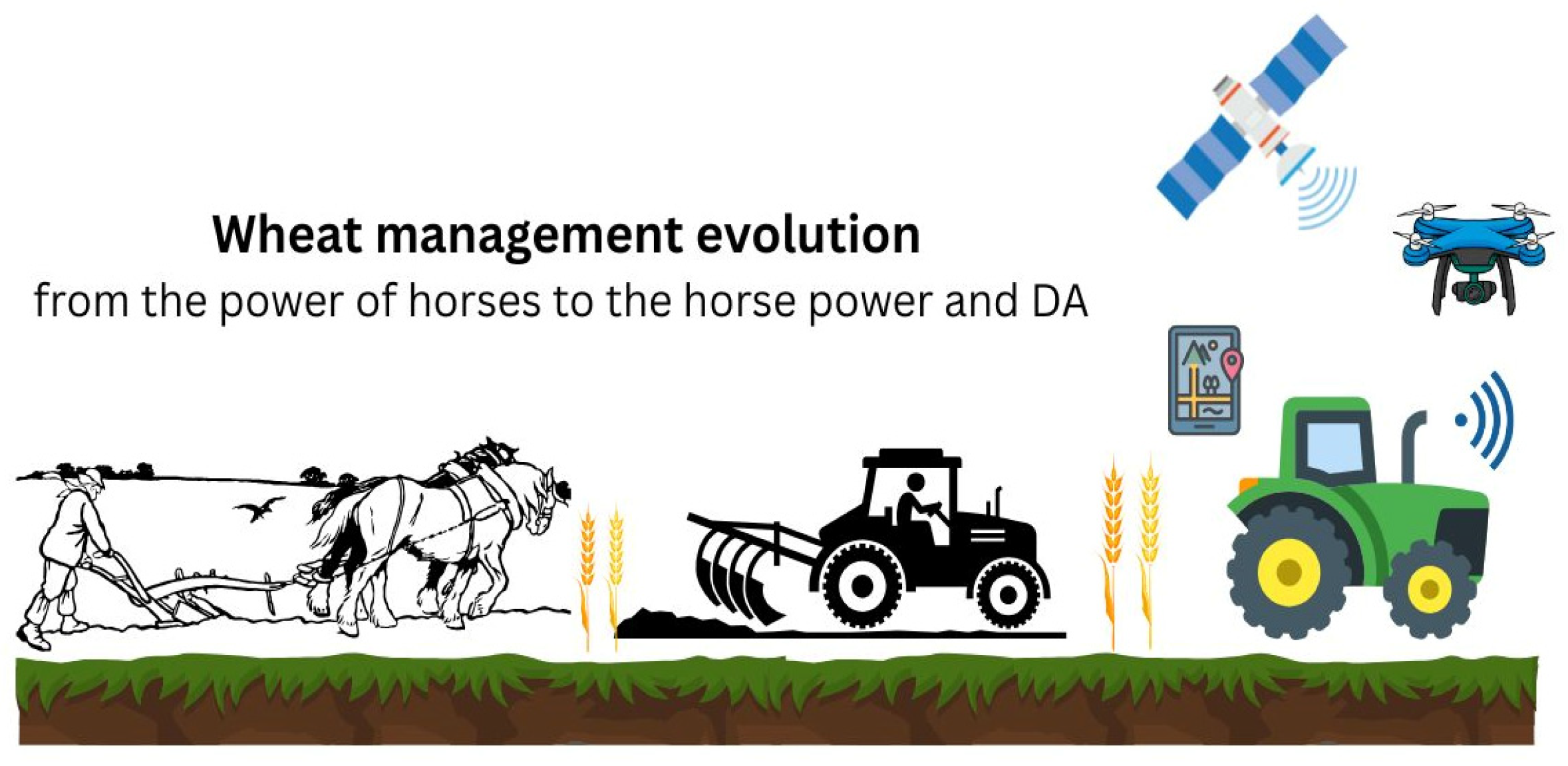



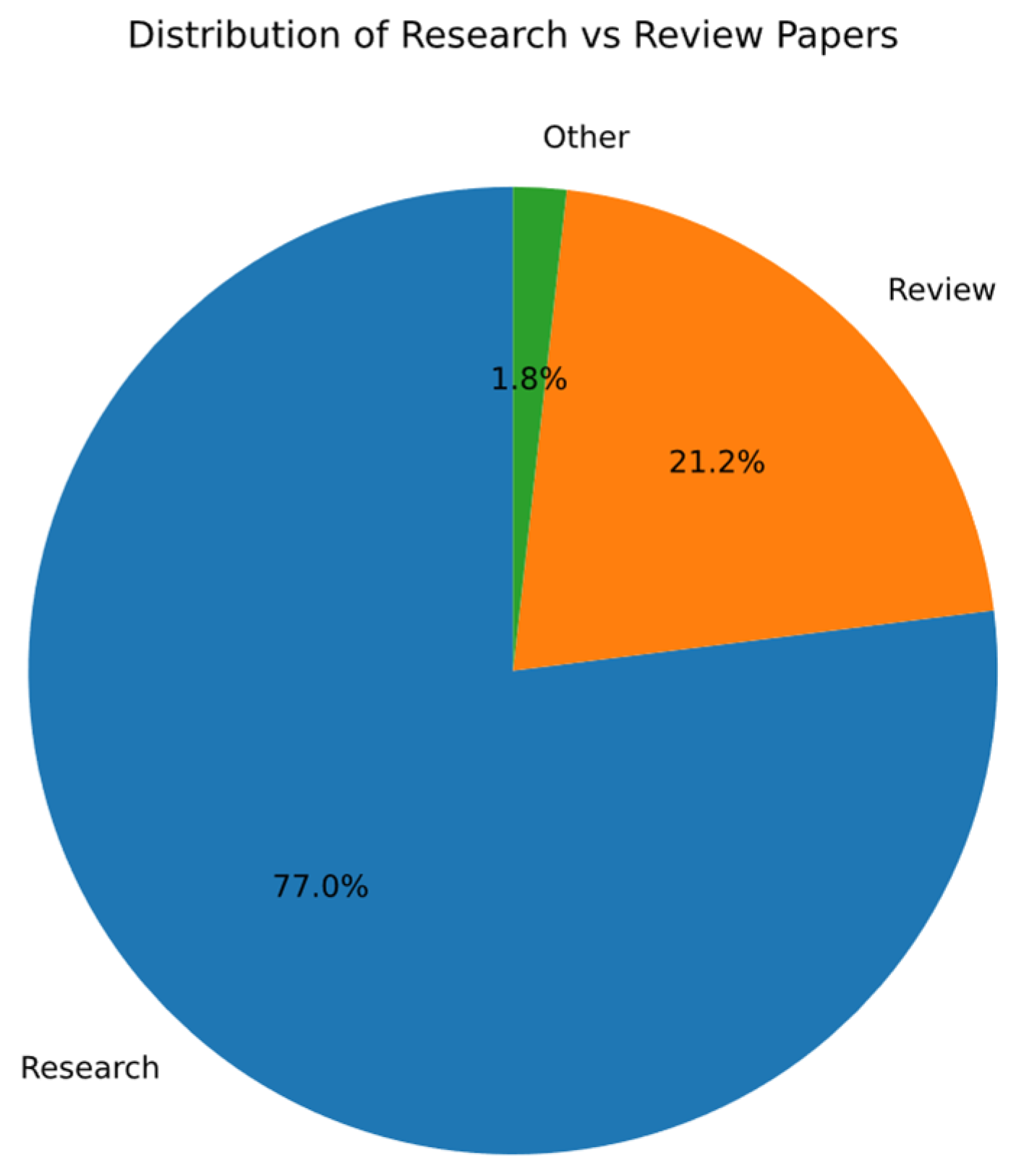




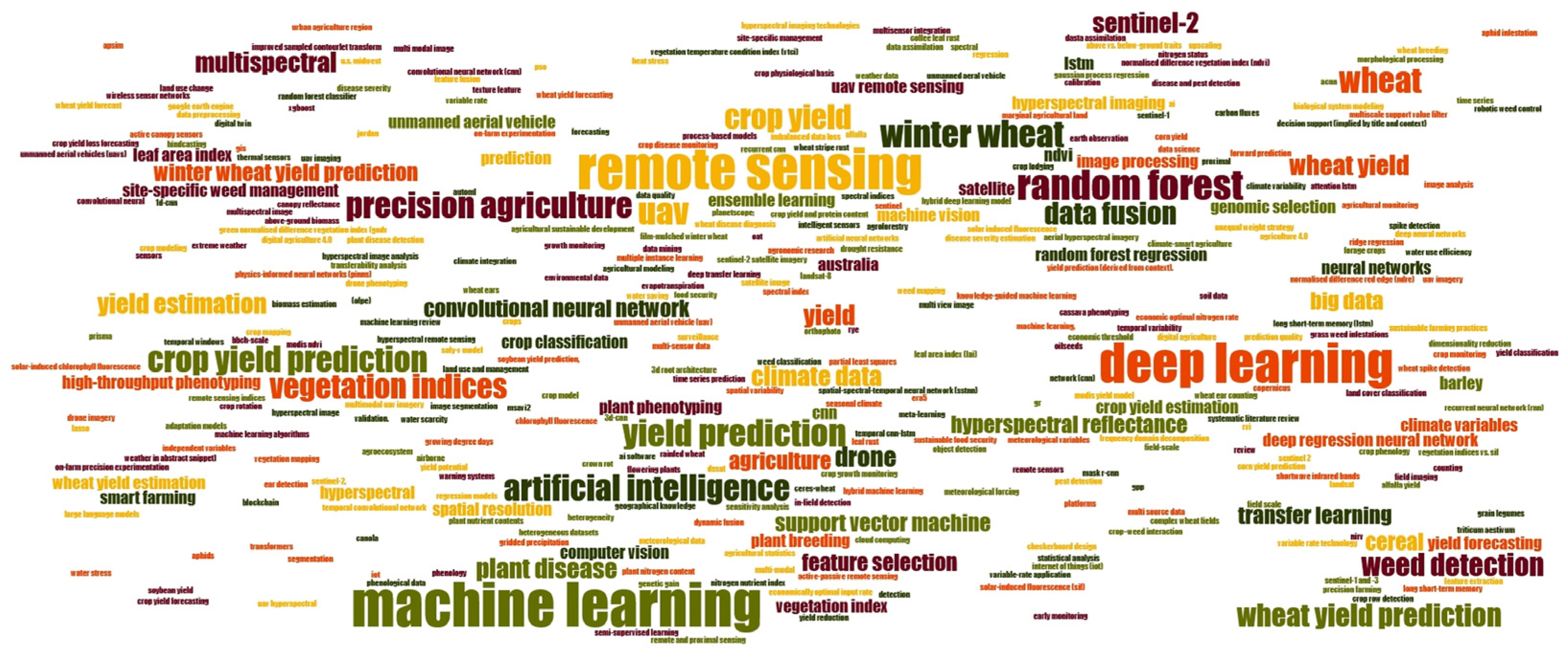
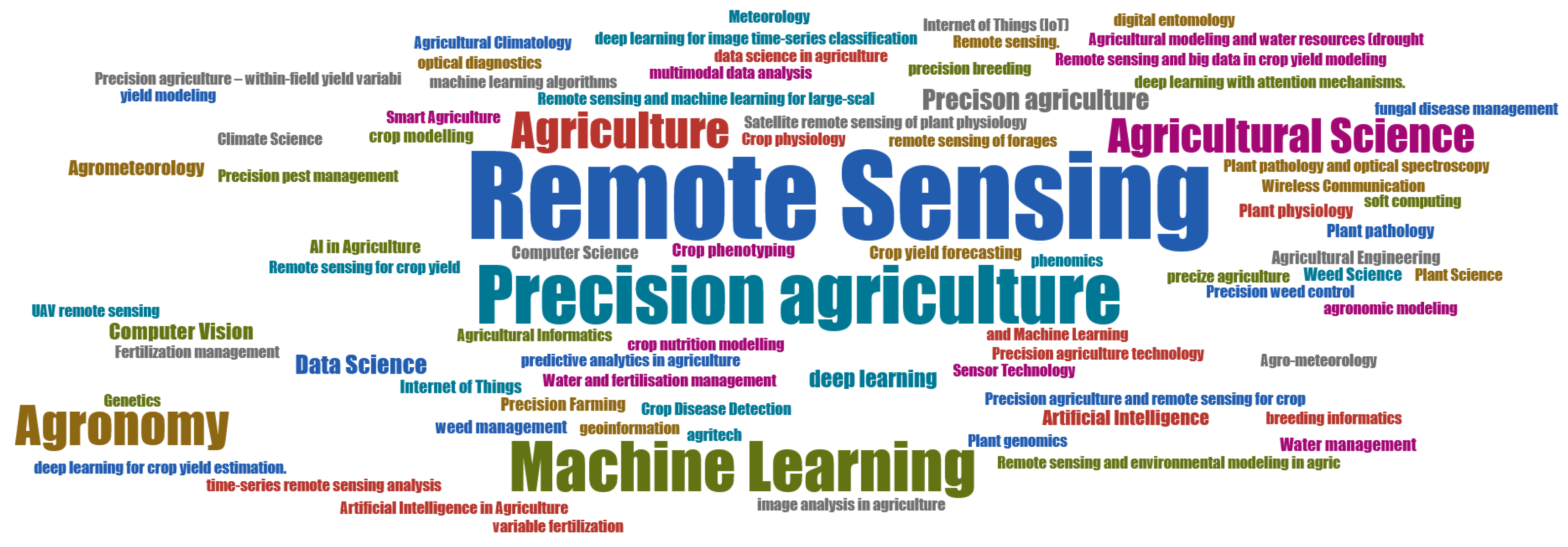

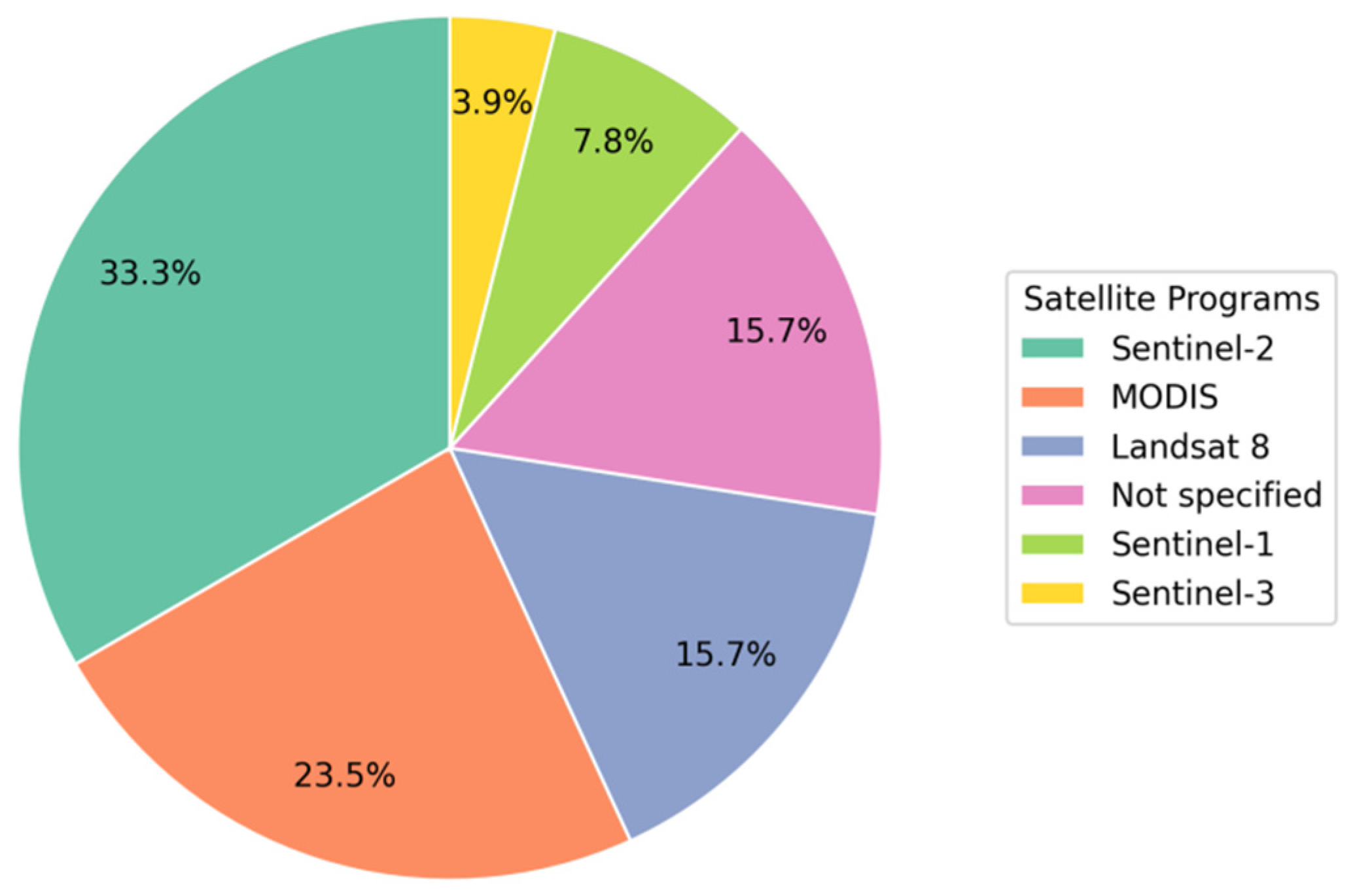
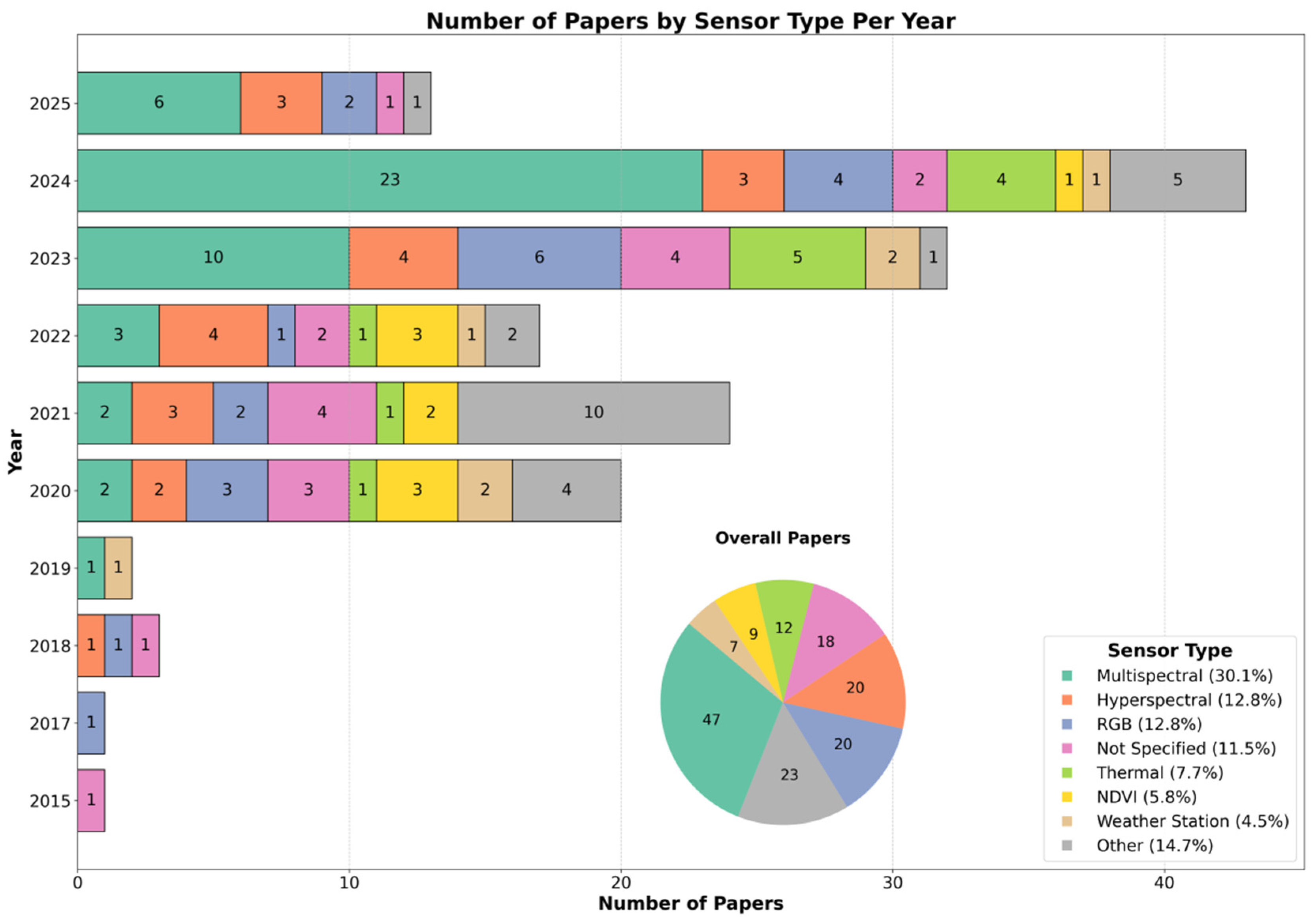
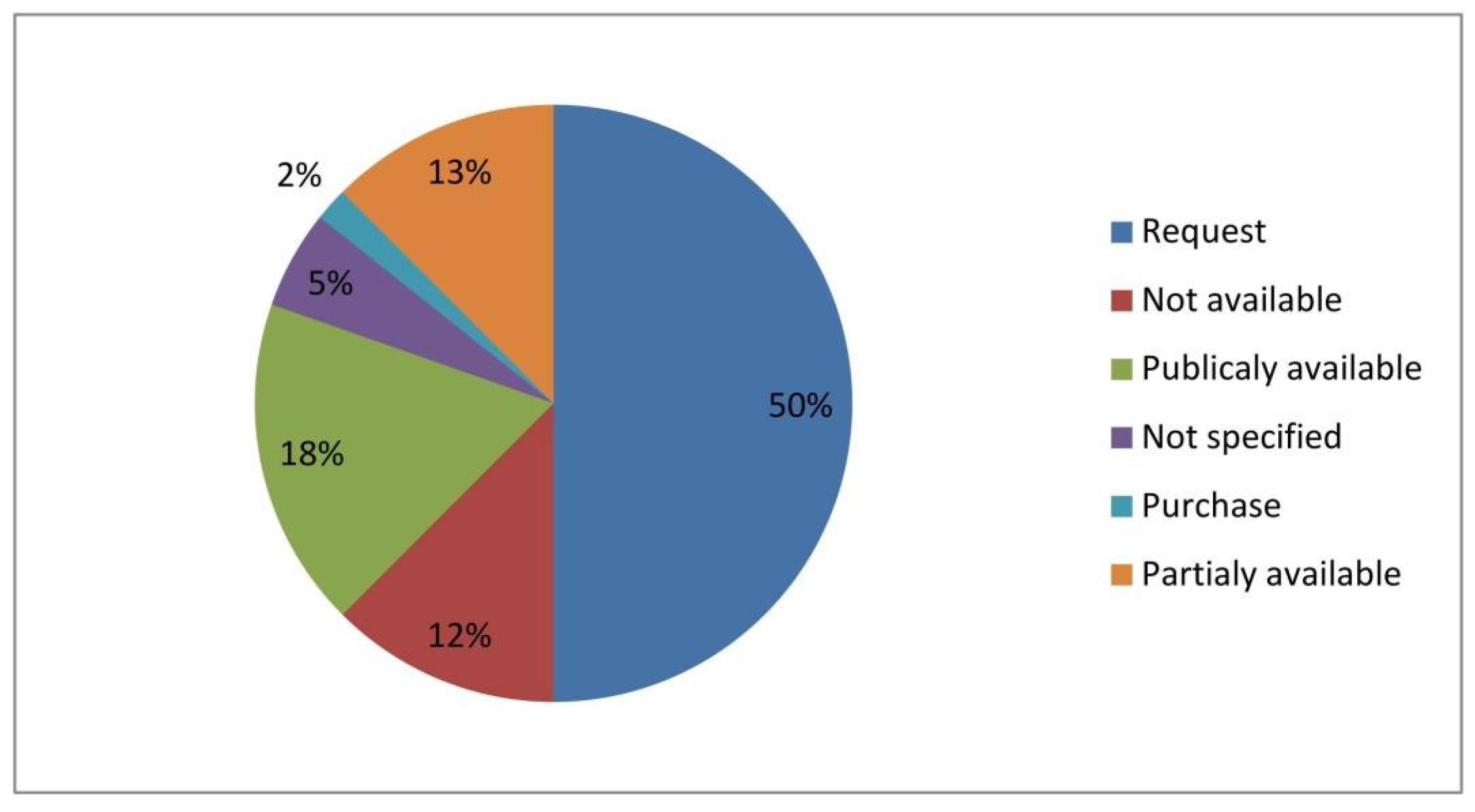
| Search Engine | Website | Search Query |
|---|---|---|
| Scopus | http://www.scopus.com/ | (“UAV” OR “UAS” OR “Drone” OR “RPAS” OR “Multispectral camera” OR “Hyperspectral camera” OR “UGV” OR “RGB Camera” OR “Image analysis” OR “Robot” or “Robotic” OR “Remote sensing”) AND (“Machine Learning” OR “Artificial Intelligence”) AND (“wheat” OR “triticum aestivum”) AND (“Disease detection” OR “weed detection” OR “pest detection” OR “Yield Prediction” OR “Yield Estimation” OR “Yield Forecast” OR “Damage Detection”) |
| Web of Science | http://www.webofscience.com/ (accessed date 14 October 2025) | (“UAV” OR “UAS” OR “Drone” OR “RPAS” OR “Multispectral camera” OR “Hyperspectral camera” OR “UGV” OR “RGB Camera” OR “Image analysis” OR “Robot” or “Robotic” OR “Remote sensing”) AND (“Machine Learning” OR “Artificial Intelligence”) AND (“wheat” OR “triticum aestivum”) AND (“Disease detection” OR “weed detection” OR “pest detection” OR “Yield Prediction” OR “Yield Estimation” OR “Yield Forecast” OR “Damage Detection”) |
| Inclusion Criteria | Exclusion Criteria |
|---|---|
| The paper must have been published between January 2015 and April 2025 | Articles published before January 2015 |
| The article must be a journal article | Non-peer-reviewed papers (such as book chapters, theses, etc.) |
| The article must be written in English | Article was not written in English |
| Must not be a duplicate | Appears in a search in a different database |
Disclaimer/Publisher’s Note: The statements, opinions and data contained in all publications are solely those of the individual author(s) and contributor(s) and not of MDPI and/or the editor(s). MDPI and/or the editor(s) disclaim responsibility for any injury to people or property resulting from any ideas, methods, instructions or products referred to in the content. |
© 2025 by the authors. Licensee MDPI, Basel, Switzerland. This article is an open access article distributed under the terms and conditions of the Creative Commons Attribution (CC BY) license (https://creativecommons.org/licenses/by/4.0/).
Share and Cite
Magazin, N.; Vujić, S.; Lalić, B.; Koči, V.; Benka, P.; Ćirić, V.; Sedlar, A.; Ćupina, B.; Bitakou, E.; Nychas, K.; et al. Wheat Production Transition Towards Digital Agriculture Technologies: A Review. Agronomy 2025, 15, 2640. https://doi.org/10.3390/agronomy15112640
Magazin N, Vujić S, Lalić B, Koči V, Benka P, Ćirić V, Sedlar A, Ćupina B, Bitakou E, Nychas K, et al. Wheat Production Transition Towards Digital Agriculture Technologies: A Review. Agronomy. 2025; 15(11):2640. https://doi.org/10.3390/agronomy15112640
Chicago/Turabian StyleMagazin, Nenad, Svetlana Vujić, Branislava Lalić, Vladimir Koči, Pavel Benka, Vladimir Ćirić, Aleksandar Sedlar, Branko Ćupina, Effrosyni Bitakou, Konstantinos Nychas, and et al. 2025. "Wheat Production Transition Towards Digital Agriculture Technologies: A Review" Agronomy 15, no. 11: 2640. https://doi.org/10.3390/agronomy15112640
APA StyleMagazin, N., Vujić, S., Lalić, B., Koči, V., Benka, P., Ćirić, V., Sedlar, A., Ćupina, B., Bitakou, E., Nychas, K., Psiroukis, V., Kotzabasaki, M. I., & Demestichas, K. (2025). Wheat Production Transition Towards Digital Agriculture Technologies: A Review. Agronomy, 15(11), 2640. https://doi.org/10.3390/agronomy15112640







